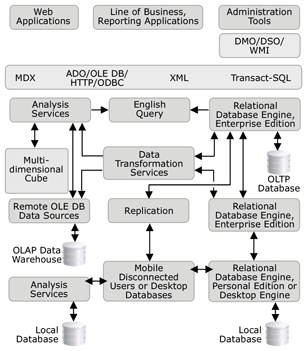SQL Server 2000
Microsoft SQL Server 2000 consists of a family of components that satisfies the data storage and analysis requirements of the largest data processing systems and commercial Web sites. SQL Server 2000 offers:
- SQL Server 2000 relational database engine stores data in relational tables. Designed as a data-tier component for use in multi-tier applications, such as those built using Commerce Server 2000 or BizTalk Server 2000, the SQL Server 2000 relational database engine is capable of handling the data storage needs of the largest Web sites.
- Microsoft SQL Server 2000 Analysis Services provides tools for analyzing and mining the data stored in data warehouses and data marts. Analysis services aggregates and summarizes data into multidimensional cubes that can then be analyzed to yield critical business intelligence information. SQL Server 2000 Analysis Services also provides data mining capabilities. The data-driven analytical approach of data mining complements the model-driven analytical approach of OLAP.
- SQL Server 2000 replication enables copies of the same database on multiple computers to improve overall system performance, while at the same time keeping those copies synchronized. SQL Server 2000 can also replicate data to data warehouses, and to or from any data source that supports OLE DB access.
- Data Transformation Services (DTS) simplifies the process of extracting data from multiple OLTP systems and building it into an OLAP data warehouse or data mart. DTS works with any data source that can be accessed with OLE DB.
- Microsoft Search Service full-text search engine supports searches for words or phrases, words in close proximity to one another, and inflectional forms of verbs and nouns. Microsoft Search Service also supports searches that reference data in file systems outside of SQL Server 2000.
- SQL Server 2000 English Query gives developers and administrators the capability to turn their relational databases into English Query applications, which allow users to query the database by typing questions in English. The developer or end user does not need to know Structured Query Language (SQL).
- Meta Data Services provides a repository for storing, viewing, and retrieving descriptions of the objects in applications and systems. Companies can use Meta Data Services as a component of an integrated information system, a native store for custom applications that process meta data, or a storage and management service for sharing reusable models.
- SQL Server 2000 administrative tools and wizards enable administrators to:
- Create, configure, and maintain databases and the objects within them, such as tables, views, and stored procedures.
- Create, configure, and maintain data warehouses and data marts.
- Create and edit multidimensional cubes.
- Configure security by authorizing users to connect to an instance of SQL Server 2000 and view specific objects in databases and cubes.
- Work with data in databases and cubes, diagnose problems, monitor database performance, and audit user access.
Most of this functionality is of limited value until a company populates its databases and cubes with data and begins running applications that work with that data. The primary functionality of SQL Server 2000 is realized by running applications that use the data access mechanisms SQL Server 2000 supports.
This diagram is an illustration of the relationships between the major components of Microsoft SQL Server 2000.

SQL Server 2000
| Previous Next |
Microsoft .NET Server Solutions for the Enterprise
ISBN: 0735615691
EAN: 2147483647
EAN: 2147483647
Year: 2002
Pages: 483
Pages: 483
Authors: Microsoft Corporation